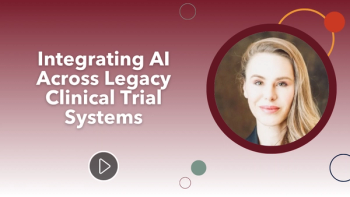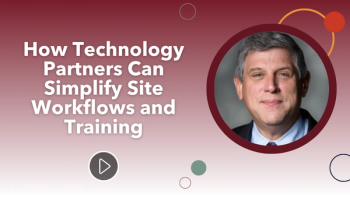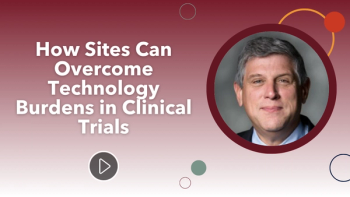
- Applied Clinical Trials-03-01-2013
- Volume 22
- Issue 3
Upgrading the Tech Suite
Efficiency and ease of use-bringing technologies together into a converged suite.
Our industry has embraced the use of clinical technologies to add efficiency, quality, speed, and transparency to the processes on managing clinical trials and collecting data. Adoption of core trial technologies such as electronic data capture (EDC), randomization and trial supply management (RTSM), and clinical trial management systems (CTMS) is high, and with this has come additional challenges around the use and management of data contained within multiple technology solutions when used together. Over recent years, most commonly used technologies and vendors have developed the ability to integrate data with other, overlapping applications. For example, subjects screened in EDC providing new subject identifiers and stratification variables to RTSM, and updating patient counts in CTMS. While this has served to reduce redundant activities duplicated between systems, and limit data reconciliation between discrete databases, inefficiency results when users are required to interact with multiple technologies when performing the tasks required of them. We are now seeing progress in this area, akin to the development of converged product suites observed in the development of other industries.
Compelling product suites address usability when a set of products are used together in ways that data integration does not achieve. Particular focus for eClinical technology vendors is how to present technology to busy study sites and sponsors, in such a way that the technology burden is low. In this article three areas that begin to achieve this are explored: common user identity, product convergence in key parts of user workflow, and data consolidation.
Common user identity
Site and sponsor users are often inconvenienced by the requirement to manage and maintain multiple sets of user credentials for each application within each clinical trial they are involved in. In addition to inconvenience and impracticality, this can lead to poor practices such as writing down credentials for easy reference. Having the same user credentials across all applications is a step forward, but better still is having a single and common identity used by all applications. In this case, users are not required to re-enter credentials when opening additional applications. This achieves huge simplicity in using suites of products, and ensures that workflow is not interrupted by log-on steps when a user moves between applications when conducting their workflow (
In addition to achieving single sign-on, a common identity management application opens the door to development and presentation of further product convergence and new composite applications, drawing functionality from more than one previously independent clinical trial technology application. The aim of these is to simplify the life of the key technology users—across sites, sponsors, and CROs—as they continue to use multiple technology solutions in combination to operate and manage their clinical trials development programs.
Product convergence
Convergence is the blurring of the boundaries between discrete applications to make workflow simpler, and is facilitated by the common identity described above. There are many examples of where convergence can add efficiency and simplicity, where tasks within individual applications overlap with another. A good example is converging EDC and RTSM functionality. Site users utilize EDC as their primary system to manage subjects and their data. It therefore improves efficiency and usability if they are able to access key patient-associated RTSM functionality through the EDC interface. This can be achieved by modifications to EDC and RTSM products, enabling core RTSM functionality to be additionally exposed as a set of underlying services that can be accessed via features within the EDC interface. This enables the blurring of the boundaries between these two eClinical technologies in a way that benefits the end user workflow and usability, without compromising on the extent of functionality available through each application. This may sound simple, but end users love it, and happy sites is a key outcome sought by all sponsors and CROs when selecting which technology applications to use in their studies.
In a recent survey responded to by 220 active site users within four large global clinical trials conducted across 28 countries, using a converged EDC-RTSM solution (Perceptive Informatics), 86% of site users considered the converged interface enabling RTSM activities to be accessed through EDC as useful or very useful. Similarly 89% found the requirement to enter the data required to randomize and dispense drugs in only one place as important or very important; and 88% found the convergence through a common drug accountability record alongside the patient data within EDC as valuable or very valuable.
Data consolidation
We are seeing huge growth in the area of data consolidation and visualization within our industry. Gone are the days where sponsor and CRO study managers need to refer to the reports from multiple systems. Now, data is consolidated through reports and dashboards that source multiple applications. The key now is to enable this approach in a scalable and cost-effective manner through the use of metadata standards; optimal information architecture; standard, re-usable extract-transform-load and data integration processes; and well designed reporting and visualization tools. Not only are consolidated data being used to understand and respond to the operational status of a study by trial managers, more recently key operational and clinical data drawn from multiple systems are seen as essential in the ability to deliver and benefit from data-driven monitoring strategies, such as risk-based or targeted monitoring. These approaches promise huge operational efficiency for sponsors and CROs while maintaining data integrity and patient safety.
None of the above can be easily achieved without an eClinical enabling platform. This underlying technology stack contains the hidden components that mean that a product suite can operate in a converged manner—through common identity management, interface convergence, and data consolidation, and incorporate third party products effectively. Essential eClinical components include dedicated software for identity management, integration, portal interfaces, reporting, document management, and information architecture. Some sponsors are seeing use of vendors' enabling platforms themselves, including the application suites they support, in a software as a service model as an attractive proposition as opposed to internal infrastructure investment and support—a move to enable even greater efficiency.
Bill Byrom, PhD, is Senior Director of Product Strategy at Perceptive Informatics, Nottingham, UK, e-mail:
Articles in this issue
over 12 years ago
Scrutinizing Non-Core Protocol Proceduresover 12 years ago
Do it Right...the First Timeover 12 years ago
Art & Science of Imaging Analyticsover 12 years ago
Business and People March 2013over 12 years ago
Patient-First Approach to Improve Oncology Clinical Trialsover 12 years ago
Testing Times for Clinical Trials in Europeover 12 years ago
Influence of Cost in the CRO Selection Processover 12 years ago
Circulating Tumor Cell Testingover 12 years ago
Cancer Experts Call for Major Research ChangesNewsletter
Stay current in clinical research with Applied Clinical Trials, providing expert insights, regulatory updates, and practical strategies for successful clinical trial design and execution.






.png)



.png)



.png)
.png)
